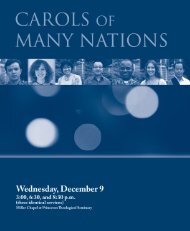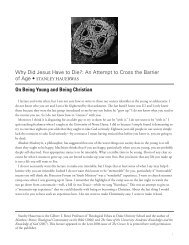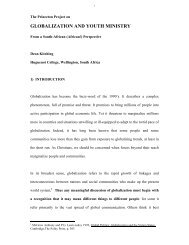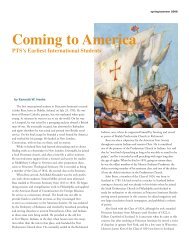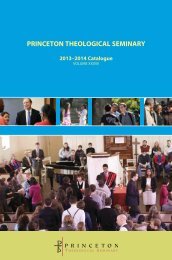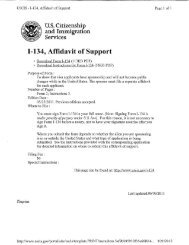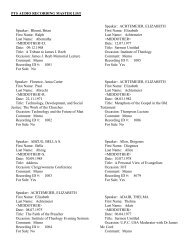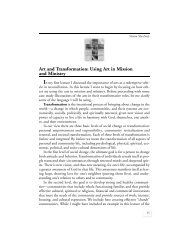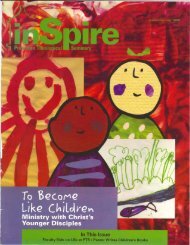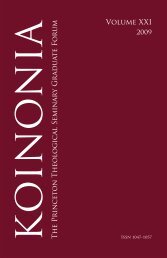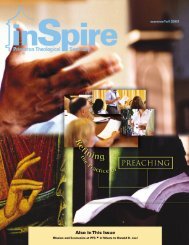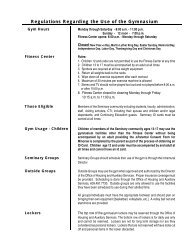P E R S P E C T I VAS - Princeton Theological Seminary
P E R S P E C T I VAS - Princeton Theological Seminary
P E R S P E C T I VAS - Princeton Theological Seminary
Create successful ePaper yourself
Turn your PDF publications into a flip-book with our unique Google optimized e-Paper software.
Perspectivas/Occasional Papers • Fall 2006Perspectivas/Occasional Papers • Fall 2006and specifically in the small town of San Juan that is located about20 miles from the U.S. Mexican border. As the son of immigrants Iinherited the oral history of my family and the experience ofsocial, economic, political, and cultural displacement that now,almost one-hundred years later, continues to resonate with theexperience of the newly arrived immigrants and the many folkswho have lived in the borderlands since before the Alamo becamethe subject of film and fable.This geographical location of the Spanish borderlands can bedescribed by the Náhuatl word “nepantla,” an indigenous termmeaning “the place in the middle.” It refers to that physical andpsychical space where one experiences displacement as a way ofbeing. In this middle zone one no longer belongs to one nation oranother but somehow one belongs to both, while being claimedby neither. In this place of ambiguity, one experiences all kinds ofdisorientation. In this place one often becomes a non-person anda member of an invisible community that shares the experience ofdislocation, cultural rejection and economic exploitation. Such isthe condition of many of our neighbors in the Southwest, especiallyamong the immigrants who come here seeking jobs and abetter way of life. The idea that “they do not belong here” or that“they need to go back to where they came from” or in the alternative“to be sent back” is a primary subject of public discourse andpublic policy in Texas and throughout the nation, as witnessedrecently by Samuel Huntington. I believe that the church is calledto offer an alternative and critical commentary from a differentparadigm.Allow me to describe a scenario that I experienced this pastsummer as I was driving from San Juan in the Rio Grande Valleyto Austin where I teach at the Lutheran <strong>Seminary</strong> of the Southwestand at the Episcopal <strong>Seminary</strong> in the Southwest. Not long afterstopping at the border check point which is located approximately90 miles from the U.S.-Mexican border, I saw three Mexican64men walking by the side of the road under the hot sun and in themiddle of nowhere, as it were, in the midst of the wild brushcountry of south Texas. They were carrying the familiar plasticgallon milk containers that I assume contained water to drink.This is a common practice among undocumented immigrantswho cross the border to go north looking for jobs. Since I wastraveling at a high rate of speed, not an uncommon experience inthose long stretches of the Texas brush country, I was unable tostop in time to offer them a ride. So I decided to go to the nextturn-around that was not too far off and headed back to try to findthem. I wanted to offer them a ride to San Antonio or to Austin.Since I could not find them I turned around again, but much to myfrustration I was unable to locate them, leading me to conjecturethree possibilities that may have occurred. The men either walkedinto the brush to continue their trek north, or someone else mayhave offered them a ride or, more than likely, they were picked upby the border patrol that often patrols those roads looking for theundocumented. The reason I suspect that these men were undocumentedimmigrants is because unlike U.S. citizens who hitchrides by a physical indication of their intent, these men did not. Infact, they were walking straight ahead without bothering to lookback at passing motorists. This lack of intent to hitch a ride was asure clue that they were not ordinary U.S. citizens.In those long stretches of Texas brush country between the RioGrande Valley and San Antonio, a distance of some 400 miles, it isnot uncommon for border patrol vehicles to stop and park in hiddennooks along the road waiting for unsuspecting immigrants inorder to deport them to Mexico. It is not uncommon along thisstretch of borderland to see many border patrol vehicles transportingthe undocumented who are in the back seat of the borderpatrol van sitting behind a grated screen, an image that is so familiaralong this route that one hardly notices anymore unlessprompted to do so. This image forms a part of the natural land-65



